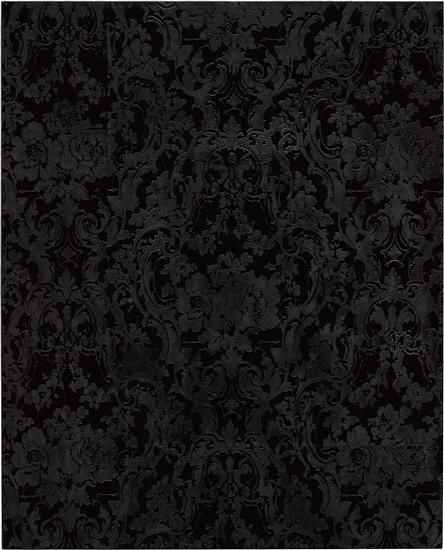Rudolf Stingel, Untitled, 2009
Rudolf Stingel, Untitled, 2009. Photo Philips
oil on canvas 82 5/8 x 66 7/8 in. (210 x 170 cm.) Signed and dated Stingel 2009 on the reverse. Estimate $500,000 - 700,000
PROVENANCE: Massimo de Carlo, Milan
“I wanted to be against a certain way of painting… Artists have always been accused of being decorative. I just went to the extreme.” RUDOLF STINGEL, 2005
Rudolf Stingel usually employs a palette of ubiquitous materials–wallpaper, Styrofoam, carpets, and rubber− amongst others− in a nod towards the legacy of arte povera, seeking to demystify the figure of the artist and the artistic process. In Untitled, 2009, a series of repeated and interlacing units initially appear to be fluid elements forming a homogeneous monochromatic black whole. Upon closer inspection, the idiosyncrasies come to light--signs of corruption in the production process, traces of organic human input render his patterned surface into a composition of unique or fragmented and blurred parts. Here, hybridity becomes subject matter. Representation, abstraction, process, pattern, performance and subjectivity are all present in Stingel’s work.
Stingel has persistently pushed the limits of painting throughout his career. His paintings, like those of many of his contemporaries, explore the traditions of abstraction and figuration. Stingel’s upbringing in the Italian Tyrol and Vienna exposed him to the unusual aesthetic amalgamation of rococo and baroque. This, alongside his education at a Tyrolean school renowned for its training in baroque decorative wood carving, has undoubtedly had a profound effect on his work. Hence, one can perceive an elaborate ornamentation in the decorative patterning of the wallpaper, yet when viewed in more detail the surface reveals itself to be unpredictable and uncertain. The variations of monochromatic black paint tones conflict with each other, forcing the viewer to justify reality and perception.
The resulting work, Untitled, 2009, is as much a refection of both the artistic input as the viewer’s perception. The legacy of Stingel in the history of art will be defined by this interface of production and perception. The present lot expresses a crowning achievement of the artist’s intent, and captivates the viewer in an equally euphoric experience.

/https%3A%2F%2Fprofilepics.canalblog.com%2Fprofilepics%2F1%2F0%2F100183.jpg)
/https%3A%2F%2Fstorage.canalblog.com%2F03%2F02%2F119589%2F96711876_o.jpg)
/https%3A%2F%2Fstorage.canalblog.com%2F11%2F31%2F119589%2F94773502_o.jpg)
/https%3A%2F%2Fstorage.canalblog.com%2F20%2F83%2F119589%2F94772815_o.jpg)
/https%3A%2F%2Fstorage.canalblog.com%2F26%2F72%2F119589%2F75604929_o.jpg)
/https%3A%2F%2Fstorage.canalblog.com%2F59%2F60%2F119589%2F26458628_o.jpg)



/http%3A%2F%2Fstorage.canalblog.com%2F08%2F01%2F119589%2F112744193_o.jpg)
/http%3A%2F%2Fstorage.canalblog.com%2F92%2F67%2F119589%2F112721762_o.jpg)
/http%3A%2F%2Fstorage.canalblog.com%2F41%2F79%2F119589%2F112274718_o.jpg)
/http%3A%2F%2Fstorage.canalblog.com%2F78%2F32%2F119589%2F110500510_o.jpg)